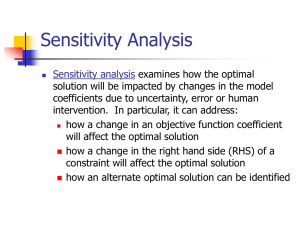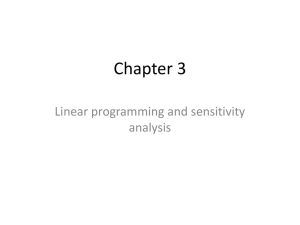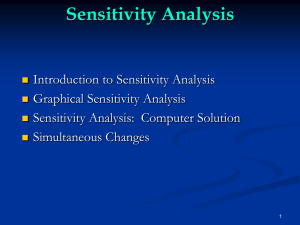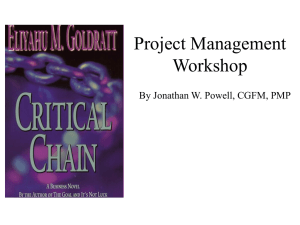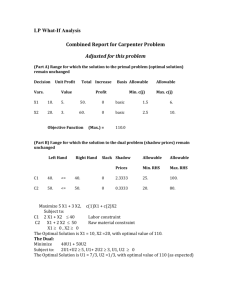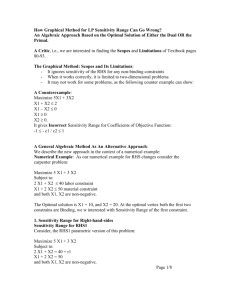LP Sensitivity Analysis Practice (with answers)
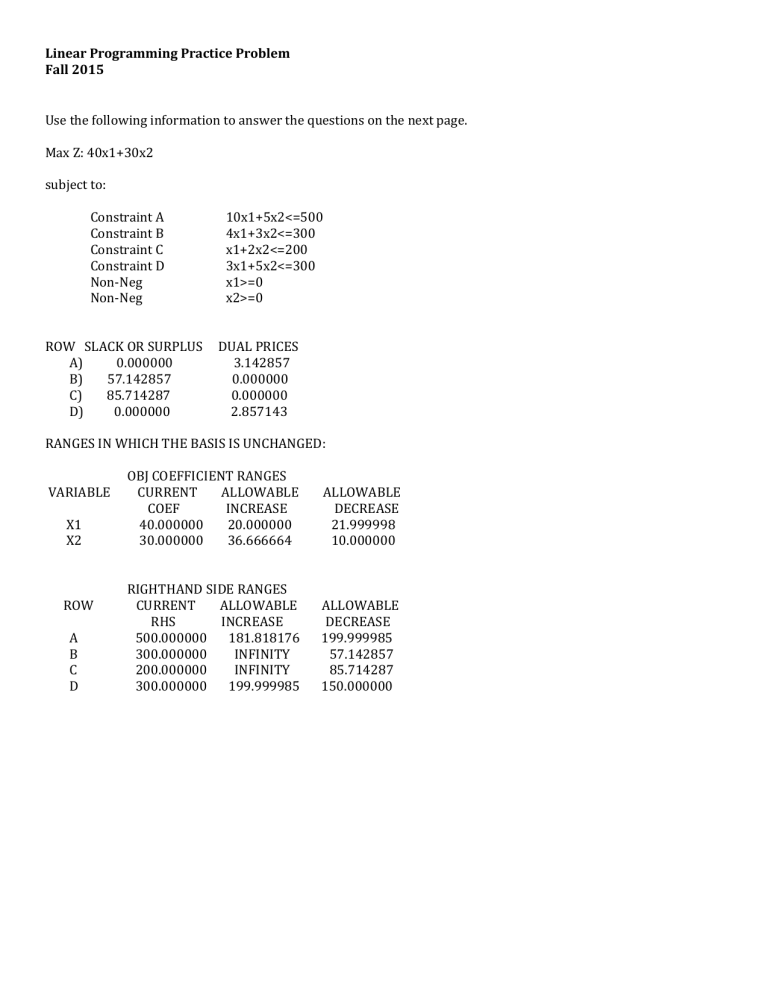
Linear Programming Practice Problem
Fall 2015
Use the following information to answer the questions on the next page.
Max Z: 40x1+30x2 subject to:
Constraint A
Constraint B
Constraint C
Constraint D
Non-Neg
Non-Neg
10x1+5x2<=500
4x1+3x2<=300 x1+2x2<=200
3x1+5x2<=300 x1>=0 x2>=0
ROW SLACK OR SURPLUS DUAL PRICES
A) 0.000000 3.142857
B) 57.142857 0.000000
C) 85.714287 0.000000
D) 0.000000 2.857143
RANGES IN WHICH THE BASIS IS UNCHANGED:
OBJ COEFFICIENT RANGES
VARIABLE CURRENT ALLOWABLE ALLOWABLE
COEF INCREASE DECREASE
X1 40.000000 20.000000 21.999998
X2 30.000000 36.666664 10.000000
RIGHTHAND SIDE RANGES
ROW CURRENT ALLOWABLE ALLOWABLE
RHS INCREASE DECREASE
A
B
C
D
500.000000 181.818176 199.999985
300.000000 INFINITY 57.142857
200.000000 INFINITY 85.714287
300.000000 199.999985 150.000000
QUESTIONS
1.
Given the information, what is the optimal combination of X1 and X2 to produce to maximize Z? What is the corresponding Z amount you earn?
2.
Which constraints would you like more of to earn more profit/revenue today?
3.
Which constraints are non-binding?
4.
If the objective function coefficient for X1 was to increase from $40 to $50, how much additional revenue would be generated?
5.
If the objective function coefficient for X2 was to increase from $30 to $70, how much additional revenue would be generated?
6.
If the objective function for X2 was to decrease from $30 to $25, what would the new total Z amount be for the day?
7.
If you were able to purchase 100 more units of Constraint A at a cost of $4.14, would you? If so, what would be the additional Z earned?
8.
If you were able to purchase 50 more units of Constraint C at a cost of $5, would you? Explain.
9.
If you were able to purchase 150 more units of Constraint D at a cost of $2.00, would you? If so, what would be the additional Z earned?
10.
If Constraint B was to decrease today to 275 units, what is the impact to the problem?
ANSWERS
1.
Given the information, what is the optimal combination of X1 and X2 to produce to maximize Z? What is the corresponding Z amount you earn?
X1 = 28.57, x2 = 42.83
Z = $2428.57
2.
Which constraints would you like more of to earn more profit/revenue today? How do you know?
A and D. They have zero slack (all used up) and a positive dual price.
3.
Which constraints are non-binding?
B and C. They have a positive slacks and zero dual price.
4.
If the objective function coefficient for X1 was to increase from $40 to $50, how much additional revenue would be generated?
This is an increase of $10, which is in the allowable range. Thus, the optimal combo stays the same.
$10 x 28.57 = $285.70 extra dollars are generated.
5.
If the objective function coefficient for X2 was to increase from $30 to $70, how much additional revenue would be generated?
You cannot tell-- because the increase of $40 is outside the allowable range. The optimal combination would change. You must resolve the problem.
6.
If the objective function for X2 was to decrease from $30 to $25, what would the new total Z amount be for the day?
This is a decrease of $5, which is in the allowable range. Thus, the optimal combo stays the same. --
-$5 x 42.83 = -$214.15. The new total Z amount = $2428.57 - 214.15 = $2,214.42
7.
If you were able to purchase 100 more units of Constraint A at a cost of $4.14, would you? If so, what would be the additional Z earned?
No. The additional units of 100 is in the acceptable range, which means the dual price of $3.14 is in effect. This value is LESS than the cost-- making the purchase too expensive. We would not make the purchase.
8.
If you were able to purchase 50 more units of Constraint C at a cost of $5, would you? Explain.
No. We do not need any more C to produce today. We already have 85 units left over. We would not purchase C to produce more for today. Nor can we judge whether it would be wise to purchase the C at this cost for future use because we don't know if it's an acceptable price.
9.
If you were able to purchase 150 more units of Constraint D at a cost of $2.00, would you? If so, what would be the additional Z earned?
Yes. 150 additional units is in the range, thus, the dual price of $2.86 is in effect. The cost is $2.00, giving us a net profit of $.86 for each unit purchased. If we buy 150 units, we generate 150 x $.86 =
$129 extra Z. The new total profit would be $2428.57 + $129 = $2,557.57.
10.
If Constraint B was to decrease today to 275 units, what is the impact to the problem?
There would be no impact to the problem. The allowable decrease for Constraint B is 50 units. The decrease to 275 represents a decrease of only 25 units. The binding constraints would remain as is-
- as would the answer.

